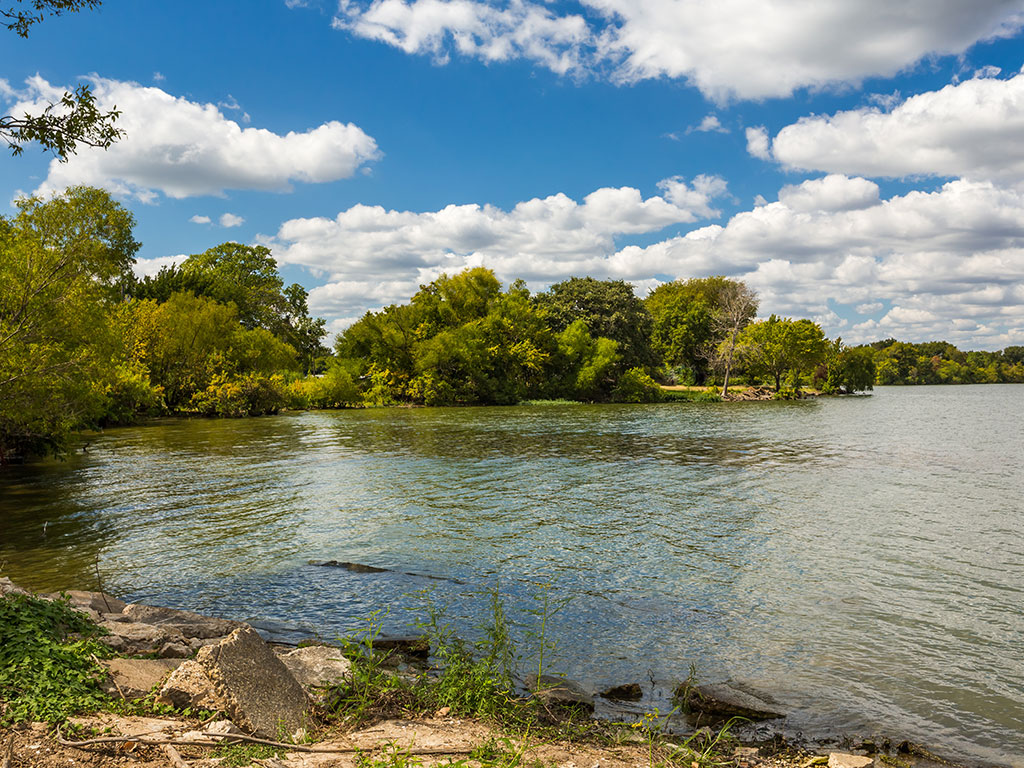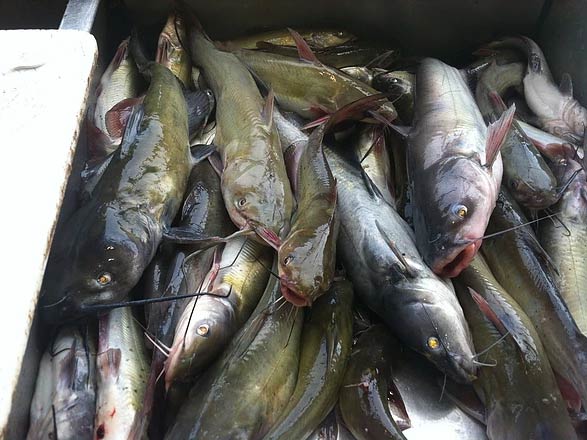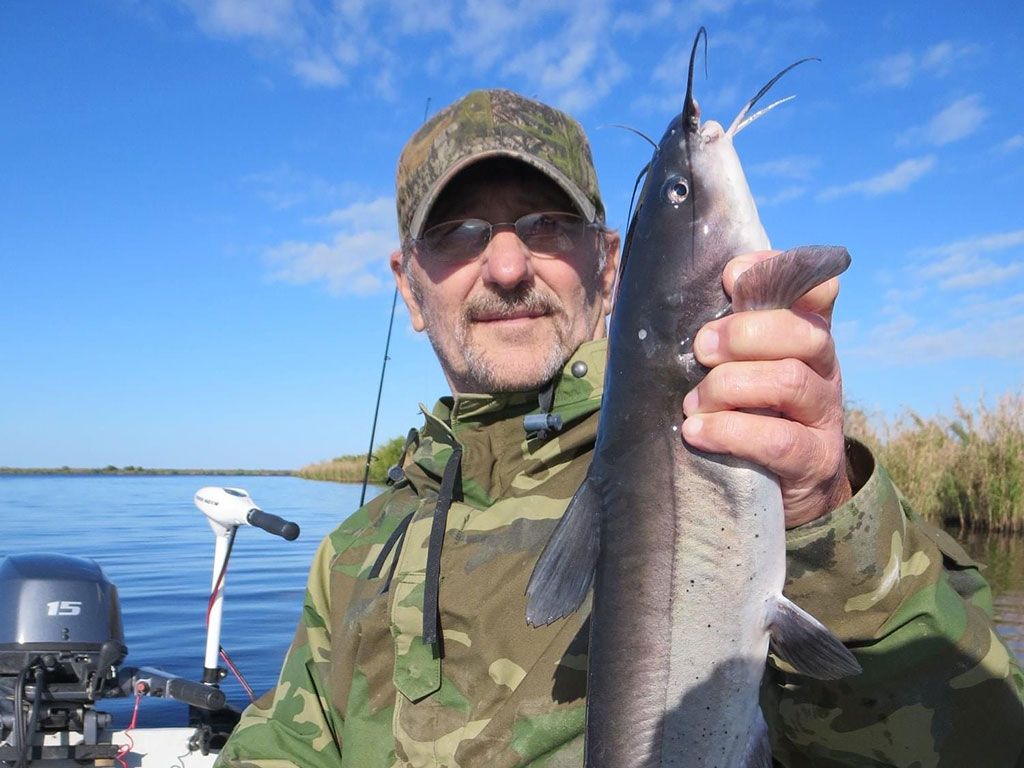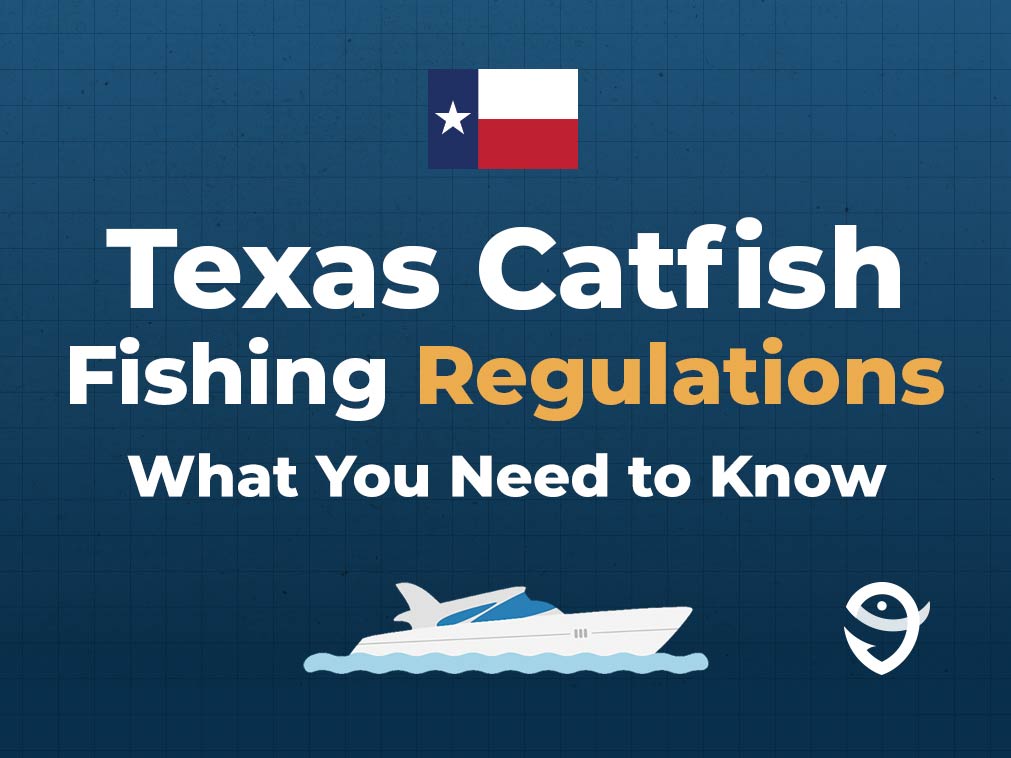The state of Texas has 10 species of freshwater Catfish, making it a great year-round location to target the beloved whisker fish. While most of the sub-species of Catfish found in Texas are Bullheads, the Lone Star State is also home to the “Big 3” – Blue, Channel, and Flathead Catfish.

In this article I’m going to cover some of the top destinations for Catfish fishing in Texas, the best time of year to go, and what kind of bait and tackle you’ll need to be successful. And trust me, with a state record Blue Catfish weighing in at 112.5 pounds, Texas knows how to grow BIG Cats!
Where to Go
The best catfishing in Texas takes place in the northern and eastern portions of the state. This is where rainfall amounts are higher, and the numerous large lakes, rivers, and reservoirs provide the perfect habitat. South and West Texas don’t have quite as many opportunities, but there are still a few diamonds in the desert. Let’s take a closer look.
North Texas

Lake Lewisville
Lake Lewisville is a 29,592 acre impoundment on the Trinity River in Denton County. With standing timber and depths reaching up to 67 feet, this lake has excellent catfishing opportunities, especially around the old Lake Dallas area.
Lake Grapevine
Not far from Lake Lewisville is the 6,684 acre Grapevine Lake. If you want to target big Blue Catfish, this is the place to go. Try using cut shad on sandbars adjacent to the many boulder fields.
Brazos River
The Brazos River is a mostly undeveloped river with healthy populations of Channel, Blue and Flathead Catfish. Known for its abundant Channel Catfish, this is a great place to fill the cooler, or try your luck at a night-time Flathead during the summer months.
East Texas

Lake Tawakoni
Most famous for its world record Blue Catfish, Lake Tawakoni is the place to go if your goal is a true trophy. Consider booking a charter or guided trip during the cold summer months when most Blue Catfish over 40 pounds are caught.
Sabine River
The Sabine River on the Texas-Louisiana border offers countless miles of river, channel, and tributary creeks for the eager Catfish angler. Keep an eye out for water levels in this area, as they can rise quickly. And, if you’re lucky you may even hook into a prehistoric Alligator Gar, too!
Lake Houston
Lake Houston, just north of its namesake city, offers urban anglers excellent catfishing opportunities, especially in the spring and summer months. This impoundment is 11,854 acres and most anglers fish along the old channels, so be sure you have an up-to-date chart or reliable electronics.
Lake Livingston
Lake Livingston is another behemoth reservoir, spanning 90,000 acres on the Trinity River. Known primarily for its White Bass, Blue and Channel Catfish are the primary Cat species in this body of water.
South Texas
Falcon Reservoir
Located about 40 miles east of Laredo Texas, this 83,654 acre reservoir provides some of the best Channel Catfish fishing in South Texas. Ask the local bait and tackle shops for the latest “stink bait” recipe and you’re sure to get some bites.
Lake Corpus Christi
Home to Channel, Flathead, and Blue Catfish, Lake Corpus Christi offers a little bit of everything. During the colder months, focus on deeper areas inside the Nueces River channel. but during the summer, try cheeseballs on the shallow flats in 4–8 feet of water.
West Texas

Millers Creek Reservoir
This remote 2,212 acre reservoir southwest of Wichita Falls is home to Channel, Blue, and Flathead Catfish. Most Catfish anglers focus on the upper portions of the impoundment. The lake record Blue Catfish was caught by Gregory Pavur in March 2020, weighing in at 42.14 pounds.
Concho River
This West Texas river flows for over 50 miles throughout Tom Green and Concho Counties, eventually joining up with the Colorado River. Big Flathead Catfish call this river system home, including a 40.5 pounder caught in April 2022 by Chase Owen Kime.
Small Lakes & Ponds
The giant lakes and reservoirs in Texas get a lot of the fishing attention, but don’t overlook the smaller lakes and ponds. In fact, sometimes these smaller unknown water bodies receive significantly less fishing pressure and can yield big and plentiful catches. Jump on Google Earth and explore your local waterways – then give them a try!
When To Go

Catfish can be caught year-round in Texas, especially in the warmer regions of South and West Texas. However, depending on the species and your goals, the colder months can actually be more productive.
- Channel Catfish: Spring and summer is the most popular time of year to target Channel Catfish, when the days are long and feeding activity is heavy. However, in South and East Texas, Channel Cats can be caught year-round due to the warmer climate. These are the most prolific species of big Catfish in Texas, and the most likely to bite year-round.
- Blue Catfish: The best Blue Catfish fishing in Texas takes place during the cold winter months. These cold tolerant fish are targeted in deep holes when water temperatures plummet. Early spring and late fall is also a good time of year for Blues.
- Flathead Catfish: Flathead catfishing in Texas peaks during the summer, especially at night, when these predatory fish prowl flats, sandbars, and rocky areas in search of their prey. During the spring and fall, focus on fishing the late afternoons around dusk.
Texas Catfishing Gear and Tackle
Most Catfish anglers in Texas use standard Catfish gear. A 6–7′ medium-heavy power rod with a 5000 series spinning reel or open-faced casting reel with a 20-40 lb test mainline will do the trick. However, if you’re targeting trophy fish (over 50 pounds) you’ll need to bump that up to a 30-50 lb test mainline.

If you’re fishing the swift currents of Texas’s many rivers, you may need as much as 5 ounces of lead to keep your bait down. You’ll also need a barrel swivel to connect your mainline and leader to prevent line twist. Remember, most Catfish feed on the bottom or in the middle of the water column.
Catfish are not line shy like Crappie or Smallmouth Bass, so don’t be afraid to beef up your line test. You need a durable and heavy pound test line to fight Catfish around the logs, rocks, and structure they often call home.
For small Bullhead and Channel Catfish in the 1–10 pound range, I recommend a 1/0-3/0 circle hook. If you’re targeting big Channel, Blue, or Flathead Catfish, size up to a 4/0-7/0 circle hook.
And if you want a more passive way to fish for Catfish, Texas does allow trotlines and bush hooks. Be sure to check the regulations for the specific lake or river you plan on fishing before trying them out, though.
Popular Catfishing Baits
To catch Catfish in Texas, you need either live, dead, or artificial baits – leave the fancy lures to the Bass anglers! Below is a breakdown of the best bait choices for each species of Texas Catfish.
Best Bullhead Catfish Baits
Bullhead Catfish average 1–3 pounds in Texas, and can be caught on a variety of baits. Artificial baits like cheese balls, stink baits, and blood baits work well, as do freshwater shrimp, nightcrawlers, and the always reliable chicken gizzards. Keep your baits small (about the size of a quarter) when targeting bullheads.
Best Blue Catfish Baits

Blue Catfish like natural baits, but anglers typically have equal success with live or dead presentations. Live or cut shad are probably the most popular choice. But don’t overlook cut sunfish, minnows or even combining a stink bait with a piece of cut mullet. The fresher, the better!
Best Channel Catfish Baits
Channel Cats are possibly the most versatile species of Catfish, and that is reflected in their dietary preferences. Anglers have success with chicken livers, dough baits, worms, crawfish, minnows, shrimp and even kool-aid soaked punch baits! Experiment with different options – the smellier the better for these.
 Pro Tip: Try using soured grain to “chum” the water before you begin fishing. This is a Texas tradition that can attract large numbers of Channel Cats to a specific area.
Pro Tip: Try using soured grain to “chum” the water before you begin fishing. This is a Texas tradition that can attract large numbers of Channel Cats to a specific area.
Best Flathead Catfish Baits

If you want to specifically target Flathead Catfish, be sure your bait is alive! Yep, Flathead Catfish primarily feed on other fish. Juvenile bluegill, shiners, and even small bullhead catfish are excellent live bait choices for Texas Flatheads. Leave the stink baits for the Channel Cats and Bullheads.
Identifying Catfish in Texas
In Texas, it’s easy to get confused between Blue and Channel Catfish, so it’s important to know how to tell the difference between them. The most reliable way to tell the difference is to look at the anal fin.
On a Channel Catfish it will be rounded with 23–29 rays. With Blue Catfish, the anal fin has a straight edge and 30–36 rays. Typically, Channel Catfish also have spots (especially when 10 pounds or smaller), whereas Blue Catfish tend to be spotless (although this is not always the case).
Texas Catfishing Rules & Regulations

Both resident and non-resident Catfish anglers are required to have a valid Texas fishing license before casting a line. Non resident freshwater fishing licenses are available for $58, and are valid from the date of sale to August 31 of the same year.
For the most up to date regulations on the lake you intend to fish, be sure to check with the Texas Parks and Wildlife Department.
Catfish Size & Slot Limits
You’ll also want to know exactly how many fish you can keep – and which size. This depends on which Catfish you’re targeting. Find a comprehensive breakdown below. But, please note, these are subject to change.
Channel Catfish, Blue Catfish, and Their Hybrid Subspecies
Daily Bag Limit: 25 (in any combination – only 10 can be 20 inches or greater in length)
Minimum Length: No size limit (however, no more than 10 fish that measure 20 inches or longer)
Flathead Catfish
Daily Bag Limit: 5
Minimum Length: 18 inches
Yellow, Brown and Black Bullhead Catfish:
Daily Bag Limit: N/A – not considered a regulated game fish
Minimum Length: No size limit
Please note: Special regulations may apply to certain water bodies throughout Texas. Consult with the Texas Parks and Wildlife Department for exclusions.
Catfish Fishing in Texas: Multiple Species = Guaranteed Fun
Texas has no shortage of fishing locations for the enthusiastic Catfish angler. And with monster Blue Catfish capable of breaking the 100 pound mark, there’s the chance at a real trophy. Remember, your bait selection and fishing location are the best way to target a specific type of Catfish. Consider hiring a professional Texas catfishing guide to help you catch the fish of your dreams!
Have you ever tried Catfish fishing in Texas? How was your experience? Any tips or tricks you’d like to share? We’d love to hear from you in the comments below!
The post Catfish Fishing in Texas: The Complete Guide appeared first on FishingBooker Blog.
https://ift.tt/dJMisj5
0 Comments
Enregistrer un commentaire